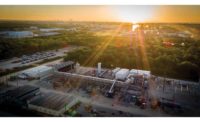Despite concerns about the viability of scaling-up the technology for commercial powerplants, utilities and engineering, procurement and construction (EPC) firms acknowledge that CCS is important. Southern Co., AEP and others are investing in research and development through entities such as Southern's National Carbon Capture Center in Birmingham, Ala. The DOE also supports research into emerging technologies through a grant program. "We think it's important that research continues [given] the way we see the regulations going in the future," says Southern's Toth.
Advanced Chemistry
Much of the research being done by engineering firms around the world is focused on making CCS more efficient. R&D efforts also are looking at promising second-generation technologies such as chemical looping, a process in which coal reacts with iron oxide-based oxygen carrier particles. The chemical reaction converts the coal to a concentrated stream of CO2 for use in enhanced oil recovery or for permanent storage and reduces iron-oxide. The reduced oxygen carrier particles are re-oxidized in a second reactor in which heat is liberated and made available to produce steam for electricity generation.
Chemical looping is considered a more cost- effective method for capturing and sequestering CO2 because it can operate without an air-separation unit on the powerplant, says Kip Alexander, vice president of technology at Babcock & Wilcox's Power Generating Group (B&W PGG). "It has lower power consumption and lower capital costs," he says.
In May, B&W PGG received a $2.5-million DOE award for phase-two development of iron-based coal direct chemical looping technology in a laboratory setting. B&W PGG previously worked with Ohio State University to successfully validate the technology at bench scale.
Alexander says, "We've either got to get the cost down" through continued research into more efficient and cost-effective CCS technologies "or there's got to be some other mechanism to draw it into the market." He adds, "[Otherwise] there will not be any new coal in the U.S. for the foreseeable future."
The best and most effective incentive, several sources say, is to develop a cap-and-trade approach with a price on CO2.
"EPA has been dealt a very difficult hand," says Stanford's Wara. In the best-case scenario, "we would have a cap-and-trade program or a carbon tax that put a price on carbon emissions that was high enough to induce technological innovation."
But the EPA does not have the authority under the Clean Air Act to do that. Wara concludes, "Working within the framework that they have, I think they are trying to craft a solution that is as tough as it can be and still be legal."
| PRECOMBUSTION-INTEGRATED GASIFICATION COMBINED CYCLE: Fuel is first gasified with oxygen to produce a synthesis gas, which is then chemically converted into separate streams of CO2 and hydrogen.Examples: Kemper county, Miss. (Under construction) and Texas Clean Energy project for summit power group in Penwell, Texas (in planning stages). |
| POSTCOMBUSTION: This type of capture uses chemical solvents, such as amine, to separate CO2 from the flue gas.Example: Boundary Dam project for SaskPower in Saskatchewan (in commissioning). |
| OXY-COMBUSTION:This process burns coal at a higher temperature in an atmosphere of pure oxygen and carbon dioxide.Example: FutureGen at Unit 4 at Ameren’s powerplant in Merodosia, Ill. (construction expected to begin later in 2014). |
|
Source: Massachusetts Institute of Technology |








Post a comment to this article
Report Abusive Comment